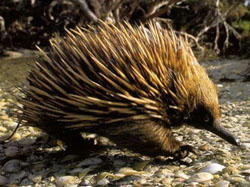MONOTREMES (The Egg-laying Mammals)
Monotremata is derived from the Greek term, monos = single and trema = hole, referring to the single excretory opening cloaca in these animals. They lay eggs instead of giving birth young ones.
Family ORNITHORYNCHIDAE
Monotrematum sudamericanum * (* indicates Extinct species)
Obdurodon dicksoni *
Obdurodon insignis *
Ornithorynchus anatinus (modern platypus)
Family TACHYGLOSSIDAE
Megalibgwilia ramsayi *
Megalibgwilia robusta *
Tachyglossus aculeata (short-nosed echidna)
Zaglossus bruijnii (Western long-beaked echidna)
Zaglossus bartoni (Eastern long-beaked echidna)
Zaglossus attenboroughi (Sir David’s long-beaked echidna)
Zaglossus hacketti *
The oldest fossil monotreme is estimated to be about 100 million year old from New South Wales, Australia. Fossils have also been found in Argentina. Today, monotremes occur only in Australia and New Guinea.
The ECHIDNA (Tachyglossus and Zaglossus)
Echidna is sometimes referred to as a Spiny Anteater since it has sharp spines on their backs. The Echidna is found all over Australia in different temperatures and habitats. Echidnas live in forests, woodlands, deserts and mountains.
They are generally crepuscular and nocturnal.
Its body is coved with 2 different types of hair: short coarse hair to keep them warm and long sharp spines, which are modified hairs. Echidnas are dark brown with lighter coloured spines. They have long jaw bones, which form a snout that has no teeth. They have ear holes and good hearing power.
The short-beaked echidna (Tachyglossus aculeatus) is found throughout Australia and southern New Guinea. The males grows to a length of about 30-45 cm and weighs up to 7 kg and the females are slightly smaller. Echidnas can live for up to 45 years.
They have a long sticky tongue, which is about 18 cm long and can be moved in and out 100 times per minute. It is perfect for catching ants, termites and insect larvae. The tongue and the roof of the mouth are covered with spines to grind up insect skeletons, making it easier for the animal to digest its food. They find ants and other insects using their sense of smell and powerful digging claws.
Echidnas are solitary animals, only coming together during the mating season, which lasts from two to three weeks in July to August. During this time, the female is followed by males from which she chooses one to mate. The female usually gives birth to only one leathery egg. The egg is placed into a ‘pouch’ made by folds of skin, where it hatches after ten days.
The foetus has an egg tooth, like reptiles and birds, which it uses to break open the leathery eggshell. The young feeds by licking milk from the milk tisse patches on the mother’s skin. It is carried in the pouch until its spines begin to grow when the mother places it in a nursery burrow hollowed in the ground. She returns frequently to feed the young echidna, which becomes independent in a year. When in danger the echidna curls up to protect its body by erect spines. If on soft ground it digs into soil, projecting sharp spines.
The PLATYPUS (Ornithorynchus anatinus)

The platypus which is the only animal in the world to have a beak, fur and webbed feet, is found in lakes, creeks, rivers and streams along the eastern side of Australia, from Cooktown in north Queensland to Hobart.
Body is exceptionally well stream-lined for aquatic life. The fur is waterproof, with an outer layer of long flat-bladed guard hairs and an inner layer of fine hairs, which trap air and maintain body temperature.
The female platypus grows to about 44.5 cm long and weighs 1.2 kg and does not have a pouch to carry her young. She lays eggs in her special nesting chamber and feeds her young on milk. The egg shells are soft. The male platypus grows to about 50 cm in length and weighs 1.6 kg. and has a hollow poisonous spur behind each of his hind legs.
The webbed feet of platypus are modified for swimming and digging. When it feeds above water level, it shakes its head from side to side so that the nerves in its bill can sense food. Their diet includes shrimps, larvae, horsehair worms, fish eggs and plants.
Platypus can live for 10 years or more. They dig burrows and build nests for laying eggs and rearing young which feed on milk that they suck from the tuft of hair located above the mother’s mammary glands. When the offspring are born they have a spur on each hind-leg which the males retain for life but the females lose within a year. The spur, which is connected to a venom gland, is about 1.5 cm long and can inflict a very serious wound and the venom is strong enough to kill a large dog.
Platypuses feed on insect larvae, fresh water shrimps, bivalve mollusks, frogs and fish eggs. They have an exceptionally sensitive bill to detect electric signals generated by the muscle activity of small prey. When foraging they dive repeatedly, capturing food and storing it in cheek pouches. The young possess teeth but they are lost as the animals mature. Adults have horny buccal pads for grinding their food.